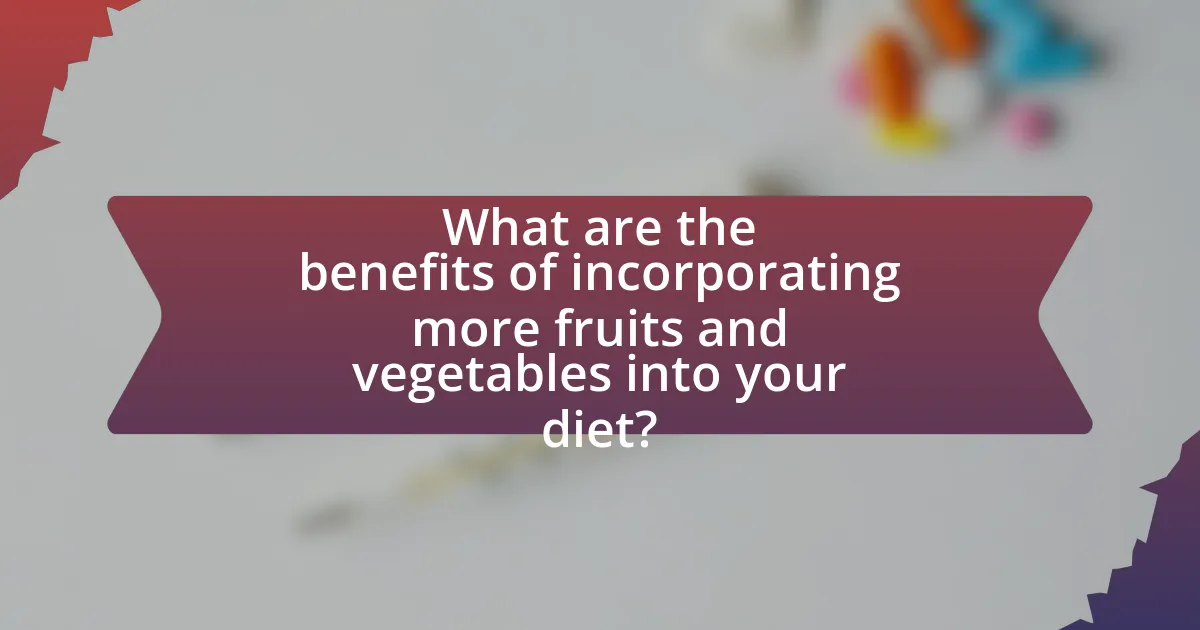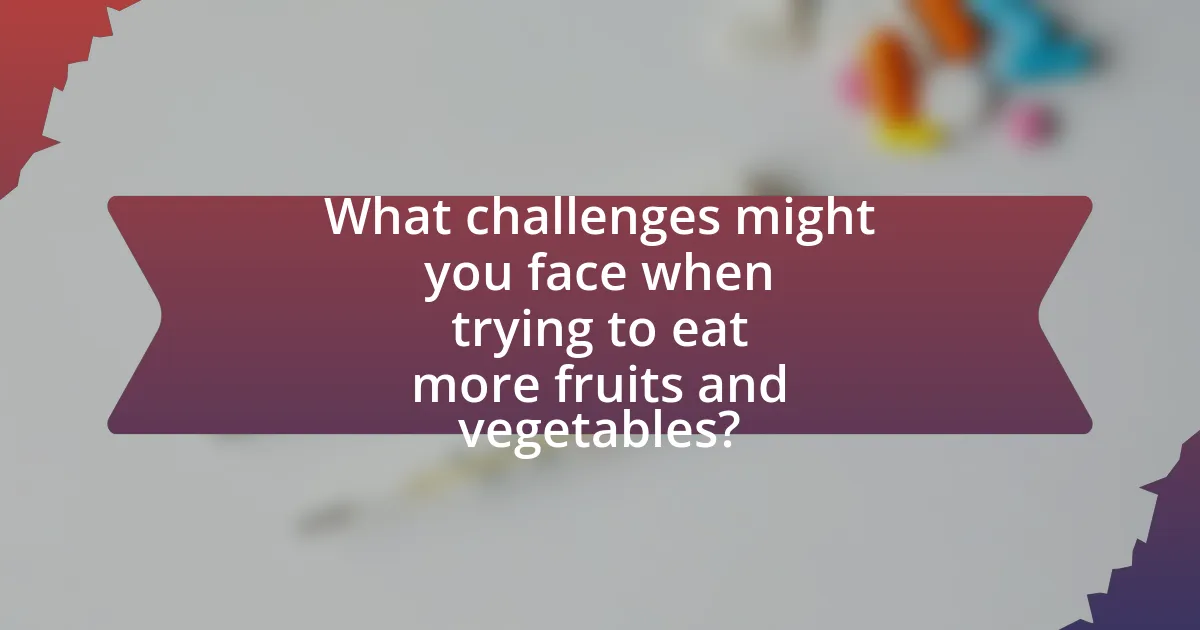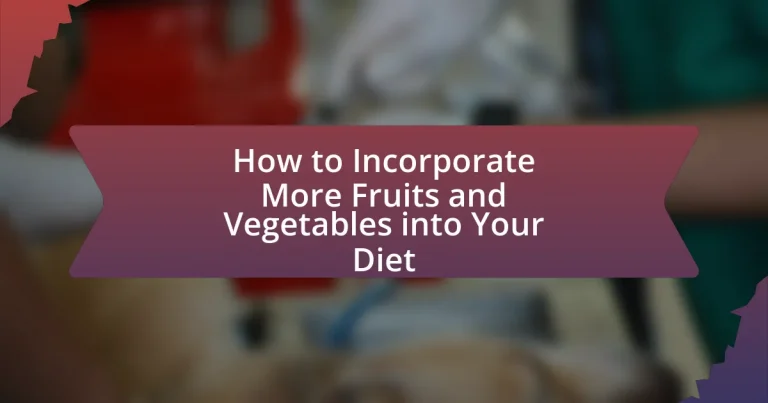The article focuses on the importance of incorporating more fruits and vegetables into one’s diet to enhance overall health and prevent chronic diseases. It outlines the numerous benefits of these foods, including their rich nutrient content, role in weight management, and ability to lower the risk of conditions such as heart disease and diabetes. The article provides practical strategies for increasing fruit and vegetable intake, such as meal planning, creative preparation methods, and addressing common barriers like cost and accessibility. Additionally, it emphasizes the recommended daily servings and offers tips for making these foods more appealing, particularly to children.

What are the benefits of incorporating more fruits and vegetables into your diet?
Incorporating more fruits and vegetables into your diet significantly enhances overall health. These foods are rich in essential vitamins, minerals, and dietary fiber, which contribute to improved digestion, reduced risk of chronic diseases, and better weight management. For instance, a study published in the journal “Circulation” found that consuming five or more servings of fruits and vegetables daily can lower the risk of heart disease by 20%. Additionally, fruits and vegetables are low in calories and high in water content, making them effective for maintaining a healthy weight.
How do fruits and vegetables contribute to overall health?
Fruits and vegetables contribute to overall health by providing essential vitamins, minerals, and dietary fiber that support bodily functions and reduce the risk of chronic diseases. For instance, fruits and vegetables are rich in antioxidants, which help combat oxidative stress and inflammation, thereby lowering the risk of conditions such as heart disease and cancer. According to the World Health Organization, a diet high in fruits and vegetables can prevent approximately 1.7 million deaths annually by reducing the incidence of these diseases. Additionally, the fiber found in these foods aids in digestion and helps maintain a healthy weight, further promoting overall health.
What specific nutrients do fruits and vegetables provide?
Fruits and vegetables provide essential nutrients including vitamins, minerals, fiber, and antioxidants. For instance, fruits are rich in vitamin C, potassium, and dietary fiber, while vegetables often contain high levels of vitamin A, folate, and iron. According to the USDA, consuming a variety of fruits and vegetables can significantly contribute to daily nutrient requirements, helping to reduce the risk of chronic diseases.
How can fruits and vegetables help prevent chronic diseases?
Fruits and vegetables help prevent chronic diseases by providing essential nutrients, antioxidants, and dietary fiber that support overall health. These foods are rich in vitamins such as vitamin C and E, which have been shown to reduce inflammation and oxidative stress, both of which are linked to chronic conditions like heart disease and diabetes. For instance, a study published in the Journal of the American College of Cardiology found that higher fruit and vegetable intake is associated with a lower risk of cardiovascular disease. Additionally, the fiber found in fruits and vegetables aids in digestion and helps maintain healthy blood sugar levels, further reducing the risk of type 2 diabetes.
Why is it important to increase fruit and vegetable intake?
Increasing fruit and vegetable intake is important because it significantly enhances overall health and reduces the risk of chronic diseases. Consuming a diet rich in fruits and vegetables provides essential vitamins, minerals, and dietary fiber, which are crucial for maintaining bodily functions and promoting optimal health. Research indicates that higher fruit and vegetable consumption is associated with a lower risk of heart disease, stroke, and certain cancers. For instance, a study published in the Journal of the American College of Cardiology found that individuals who consumed at least five servings of fruits and vegetables daily had a 20% lower risk of cardiovascular disease compared to those who consumed fewer servings. Therefore, increasing fruit and vegetable intake is vital for improving health outcomes and preventing disease.
What are the recommended daily servings of fruits and vegetables?
The recommended daily servings of fruits and vegetables are at least five servings combined. This guideline is supported by health organizations such as the World Health Organization, which suggests that consuming a variety of fruits and vegetables can reduce the risk of chronic diseases and improve overall health. Specifically, this can include two to three servings of fruits and two to three servings of vegetables each day, emphasizing the importance of diversity in choices to maximize nutritional benefits.
How does increasing intake affect weight management?
Increasing intake of fruits and vegetables can positively affect weight management by providing low-calorie, nutrient-dense options that promote satiety. Research indicates that diets rich in fruits and vegetables are associated with lower body weight and reduced risk of obesity, as these foods are high in fiber and water content, which help individuals feel full with fewer calories. A study published in the journal “Obesity” found that increasing fruit and vegetable consumption led to a significant reduction in overall caloric intake, supporting weight loss efforts.

What are some practical strategies for adding more fruits and vegetables to your meals?
Incorporating more fruits and vegetables into meals can be achieved through several practical strategies. One effective method is to add fruits and vegetables to every meal; for instance, include spinach in omelets, berries in yogurt, or peppers in pasta dishes. Research indicates that increasing the variety of fruits and vegetables consumed can enhance overall dietary quality and nutrient intake. Another strategy is to prepare snacks that feature fruits and vegetables, such as carrot sticks with hummus or apple slices with peanut butter, making them easily accessible. Meal prepping can also facilitate the inclusion of these foods; chopping vegetables in advance or preparing fruit salads can save time and encourage consumption. Additionally, substituting fruits and vegetables for less healthy ingredients, like using zucchini noodles instead of pasta, can increase intake while reducing calories. These strategies are supported by dietary guidelines that recommend filling half of your plate with fruits and vegetables to promote health and prevent chronic diseases.
How can meal planning help incorporate more fruits and vegetables?
Meal planning can significantly help incorporate more fruits and vegetables by providing a structured approach to grocery shopping and meal preparation. By planning meals in advance, individuals can ensure that they include a variety of fruits and vegetables in their diets, reducing the likelihood of impulse purchases of less healthy options. Research indicates that people who engage in meal planning consume more fruits and vegetables, as it encourages them to think ahead about their nutritional needs and make conscious choices. For example, a study published in the Journal of Nutrition Education and Behavior found that meal planning is associated with higher fruit and vegetable intake among families, highlighting its effectiveness in promoting healthier eating habits.
What are some easy meal prep ideas that include fruits and vegetables?
Easy meal prep ideas that include fruits and vegetables are essential for a healthy diet. One effective method is to prepare vegetable stir-fries with a mix of bell peppers, broccoli, and carrots, which can be stored in the refrigerator for up to five days. Another idea is to create fruit and vegetable salads, combining spinach, kale, cherry tomatoes, and diced apples, which can be dressed with a light vinaigrette and kept fresh for several days. Additionally, smoothie packs can be prepped by portioning out spinach, bananas, and berries in freezer bags, allowing for quick blending in the morning. These meal prep strategies not only enhance nutrient intake but also save time during busy weekdays.
How can you create a balanced plate with fruits and vegetables?
To create a balanced plate with fruits and vegetables, fill half of your plate with a variety of colorful fruits and vegetables. This approach ensures a diverse intake of essential vitamins, minerals, and fiber. Research indicates that consuming a variety of fruits and vegetables can reduce the risk of chronic diseases; for instance, the CDC recommends aiming for at least five servings daily to promote health benefits. Incorporating different colors, such as leafy greens, red peppers, and berries, enhances nutrient diversity, supporting overall well-being.
What are some creative ways to enjoy fruits and vegetables?
Creative ways to enjoy fruits and vegetables include making smoothies, creating vegetable chips, and incorporating them into desserts. Smoothies blend fruits and vegetables, making them easy to consume while retaining nutrients. Vegetable chips, made by baking or dehydrating vegetables like kale or sweet potatoes, provide a crunchy snack alternative. Additionally, fruits can be used in desserts, such as fruit salads or fruit-based sauces, enhancing flavor while promoting healthy eating. These methods not only increase fruit and vegetable intake but also make them more appealing and enjoyable.
How can smoothies and juices be used to increase intake?
Smoothies and juices can be used to increase intake of fruits and vegetables by providing a convenient and palatable way to consume larger quantities in a single serving. These beverages can blend multiple servings of fruits and vegetables, making it easier to meet daily recommended intake levels. For example, a smoothie containing spinach, banana, and berries can deliver the nutritional benefits of several servings of produce, which is particularly beneficial for individuals who struggle to eat enough whole fruits and vegetables. Research indicates that incorporating smoothies and juices into the diet can lead to increased overall fruit and vegetable consumption, as they can enhance flavor and mask the taste of less preferred ingredients, thus promoting healthier eating habits.
What are some recipes that highlight fruits and vegetables?
Some recipes that highlight fruits and vegetables include a quinoa salad with cherry tomatoes, cucumbers, and avocados, a vegetable stir-fry featuring bell peppers, broccoli, and carrots, and a fruit smoothie made with spinach, bananas, and berries. These recipes utilize a variety of fresh produce, promoting a balanced diet rich in vitamins and minerals. For instance, the quinoa salad provides protein and fiber, while the vegetable stir-fry offers antioxidants and essential nutrients. The fruit smoothie combines leafy greens with fruits, making it an easy way to increase daily fruit and vegetable intake.

What challenges might you face when trying to eat more fruits and vegetables?
When trying to eat more fruits and vegetables, individuals may face challenges such as accessibility, cost, and preparation time. Accessibility can be an issue in areas with limited grocery stores or markets that offer fresh produce. According to the USDA, food deserts, which are regions with limited access to affordable and nutritious food, affect millions of Americans. Cost is another significant barrier, as fresh fruits and vegetables can be more expensive than processed foods, making it difficult for some individuals to prioritize them in their diets. Additionally, preparation time can deter people from consuming more produce, as many may find it time-consuming to wash, cut, and cook fruits and vegetables compared to ready-to-eat options. These challenges collectively hinder the ability to incorporate more fruits and vegetables into daily meals.
How can you overcome common barriers to eating more fruits and vegetables?
To overcome common barriers to eating more fruits and vegetables, individuals can implement strategies such as meal planning, increasing accessibility, and experimenting with preparation methods. Meal planning allows for the intentional inclusion of fruits and vegetables in daily meals, which can lead to increased consumption. Research indicates that individuals who plan their meals are more likely to meet dietary recommendations for fruits and vegetables. Increasing accessibility involves keeping fruits and vegetables visible and readily available at home, which can encourage spontaneous consumption. Additionally, experimenting with different preparation methods, such as roasting or blending, can make fruits and vegetables more appealing, thus overcoming taste-related barriers. Studies show that varied preparation can enhance flavor and texture, making these foods more enjoyable.
What are some tips for dealing with cost and accessibility issues?
To effectively deal with cost and accessibility issues related to incorporating more fruits and vegetables into your diet, consider buying seasonal produce, which is often cheaper and fresher. Seasonal fruits and vegetables typically cost less due to higher availability, reducing transportation and storage expenses. Additionally, purchasing in bulk can lower costs; for instance, buying larger quantities of frozen fruits and vegetables can provide savings while ensuring you have nutritious options on hand. Community-supported agriculture (CSA) programs also offer affordable access to fresh produce directly from local farms, often at a lower price than retail stores. Furthermore, utilizing local farmers’ markets can provide access to fresh, affordable produce while supporting local economies. These strategies collectively enhance both the affordability and accessibility of fruits and vegetables in your diet.
How can you address taste preferences and picky eating habits?
To address taste preferences and picky eating habits, gradually introduce new fruits and vegetables alongside familiar favorites. Research indicates that repeated exposure to a food can increase acceptance; for example, a study published in the journal “Appetite” found that children who were repeatedly offered a new vegetable were more likely to try and enjoy it over time. Additionally, involving individuals in the preparation of meals can enhance their willingness to try new foods, as they may feel a sense of ownership and curiosity about the dishes they help create.
What are some best practices for incorporating fruits and vegetables into your diet?
Incorporating fruits and vegetables into your diet can be effectively achieved by planning meals that prioritize these food groups. Meal planning allows individuals to ensure that fruits and vegetables are included in every meal, making it easier to meet the recommended daily intake of at least five servings. Additionally, keeping fruits and vegetables visible and accessible, such as placing them at eye level in the refrigerator or on the kitchen counter, encourages consumption. Research indicates that people are more likely to eat fruits and vegetables when they are readily available, as highlighted in a study published in the American Journal of Preventive Medicine, which found that increased accessibility leads to higher intake levels. Furthermore, experimenting with different cooking methods, such as steaming, roasting, or blending, can enhance the appeal of these foods, making them more enjoyable to eat.
How can you make fruits and vegetables more appealing to children?
To make fruits and vegetables more appealing to children, present them in fun and engaging ways. For example, cutting fruits and vegetables into interesting shapes or arranging them into colorful patterns can capture children’s attention. Research indicates that children are more likely to eat fruits and vegetables when they are visually appealing; a study published in the journal “Appetite” found that children consumed 50% more fruits and vegetables when they were served in a playful manner. Additionally, involving children in the preparation process can increase their willingness to try new foods, as they feel a sense of ownership over the meal.
What are some tips for storing and preserving fruits and vegetables effectively?
To store and preserve fruits and vegetables effectively, keep them in a cool, dry place and use breathable containers. For example, apples and bananas should be stored at room temperature, while leafy greens thrive in the refrigerator’s crisper drawer. Ethylene-producing fruits like bananas should be kept separate from ethylene-sensitive vegetables to prevent spoilage. Additionally, washing fruits and vegetables only before consumption rather than before storage helps maintain their freshness. Research indicates that proper storage can extend the shelf life of produce by up to 50%, ensuring that they remain nutritious and flavorful for longer periods.





